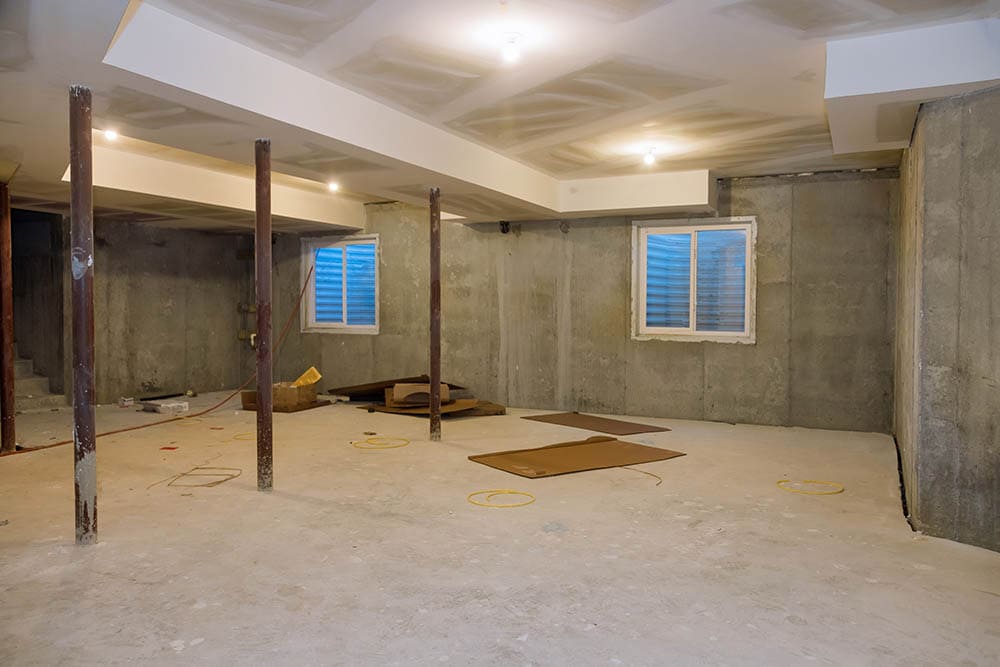What Is The Cost Of Digging Out a Basement in 2025?
-
Codee Chessher
- Last updated:

Basements, much like attics, are invaluable spaces in any home. When you need more space in your house, sometimes the answer is digging out your basement. Many “standard” basements have a paltry height of 6 feet, which is constricting when you want to use your basement to its fullest.
If you’d like to use your basement for more than laundry or storage, expanding it is a great way to do that. Increasing the height can be just the thing to turn your dull basement into a guest room, home theater, or any number of other options.
Several techniques are available for expanding basements, but underpinning is the most common type. Let’s check out how much digging out a basement with underpinning costs, which alternatives are available, and more.
What Is Basement Underpinning?
Underpinning refers to work involving the foundation, but it has another meaning when increasing the usable space within a basement. Either way, underpinning deals with your home’s foundation, which is complex and labor-intensive work.
It involves digging up the basement floor, removing the existing footings, and placing new footings at the new floor level of the basement. The critical part of this process is keeping the structure braced while it’s being excavated, which is why professionals are needed. Underpinning your basement stabilizes the foundation, which is a handy benefit, but that’s not all it does; it increases your usable square footage and can hide unsightly aspects of your basement.
Underpinning can hide support columns, water heaters, and other nonessential components of the basement. It can go a long way toward turning your basement into a more functional and attractive part of your home. Digging out your basement with underpinning is a great way to expand your house if you cannot build another story or expand outward, and it usually doesn’t disturb other parts of your house.

How Much Does Basement Underpinning Cost?
Any significant modification to your home is expensive, and underpinning is no exception. The average basement expansion is around 2 feet, giving the whole space more height. Average costs of basement underpinning range from $300 to $450 per linear foot, not to be confused with square feet.
The final cost of underpinning depends on how big your basement is. An 800-square-foot basement expanded from a 6-foot-height to an 8-foot-height can cost as much as $40,000 to $60,000 when finished. This includes additional costs necessary to fully complete the work, which we will discuss in more detail.
Additional Costs to Consider
On top of excavation, the costs include pouring concrete, waterproofing the basement, installing a sump pump, and finishing work. Together, they substantially raise the price of your average basement expansion.
- Pouring Concrete Slab: $20 per square foot
- Drainage including Sump Pump Installation: $4,000 to $6,000 (one-time)
- Demolition: $4–8 per square foot
- Finishing: Depends heavily on preference
Depending on your basement and your house, other work may be involved to dig out the basement floor, which can make the job more complicated and costly, not to mention time-consuming. If you have support beams in the middle of your basement, the contractor must install new ones, typically metal beams.
If you want a separate entrance for your basement (often called a walkout), that will cost more, too. As a final example, your whole project will cost more if you have limited space for the contractor to work. Limited access means slower work, so they need to charge more to make it worth their time and effort.
How Long Does It Take To Dig Out a Basement?
You’re looking at 3–4 weeks for most underpinning jobs, not counting extras like finishing the basement or adding a walkout entrance. You should bear in mind that any number of issues can delay this figure. If you need to relocate electrical panels, water heaters, or build new stairs, it adds time and money.
Basement Underpinning vs. Basement Benching
Underpinning isn’t the only way to dig out a basement. Benching or bench pinning is a method of lowering your basement that doesn’t dig out the foundation. Instead, the contractor will use “benches” around the perimeter of the basement to marginally expand the space. Finished basements will have a distinct “bench” around the outside, which many people disguise with cabinetry or other storage solutions.
Overall, benching is cheaper than underpinning because it doesn’t touch the foundation or original footings. It’s an attractive alternative, but the biggest downside is that benching doesn’t add nearly as much space to the basement. In many cases, benching actually reduces the usable square footage of the basement.
Is Basement Underpinning Worth It?
For large homes with large basements, the cost of underpinning can approach the market value of a small home! This makes it cost-prohibitive in cheaper housing markets and more attractive in expensive housing markets. Depending on the location, adding a story to your home or building a new bedroom is cheaper.
In some situations, it makes sense to dig out a basement. For example, it makes more financial sense to underpin a basement in New York City or Los Angeles than in a small Midwest city.
If a property is worth a million dollars and moving to a larger space isn’t possible, it turns out cheaper to dig out the basement. Conversely, you probably don’t want to spend up to $50,000 to dig out a basement for a house that’s only worth $250,000.
Conclusion
Like many home renovation projects that involve modifying the foundation or structural aspects of your property, underpinning is expensive. Basement underpinning is a great way to get some additional space in your basement, whether creating a game room, den, or home theater. In many cases, it’s cheaper to expand up or outward, but basement expansions are more practical for high-end properties.
Featured Image Credit: ungvar, Shutterstock
Contents


